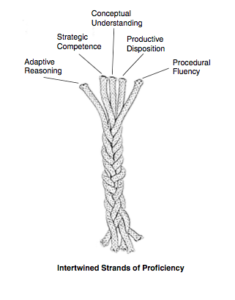We started the morning by reviewing #6 from the area sheet we worked on yesterday afternoon (p. 4.9). Beth was very brave to share with us where she was stuck and then very gracious as we practiced asking her purposeful questions to help her move ahead in her thinking.
Then Fran led a pedagogy section about “asking purposeful questions” and “eliciting and using student thinking.” We watched a video of an 8th-grade math class (from Pittsburgh Public Schools!!) and noticed a number of things about the teacher’s questioning patterns. We then examined the transcript of the video, looking at specific parts to unpack her questioning patterns further. [All of these materials are available from the NCTM Principles to Action Professional Learning Toolkit. Lin found out that you don’t need to a member to access some materials!!] Participants got a copy of the PBS Teacherline Question Starters.
Fran then shared information about the National Council of Teachers of Mathematics (NCTM.org). Lots and lots of good resources; NCTM Regional Conference is in Philadelphia this fall; K-8 schools are offered a special deal on institutional membership. Don’t forget that we have a Pennsylvania Council of Teachers of Mathematics (PCTM). Then we looked at the Illuminations website, which also contains lots of quality lesson plans and interactive applets. Another good website for interactive applets is the National Library of Virtual Manipulatives.
Then, we dove back into the math. We learned how to motivate the rules for multiplying signed numbers. We then spent a lot of time on the distributive property. We saw how this can be used to help develop students’ number sense (for instance, recognizing that 201 x 5 is 200 x 5 + 1 x 5) and also to build toward algebra (FOIL… but that only works when you’re multiplying something with two terms times something else with two terms).
We stopped for lunch a bit early in order to get our picture taken with the Lion Shrine.
After lunch, we continued with the distributive property, extending its application to situations where there are more than two terms multiplied together. We talked about extending the area model to a volume model. We showed how the distributive property, together with the adjective-noun theme, can motivate the standard algorithm for multiplication.
Just before the break, we started to consider division. We discussed how there are two types of questions that can be answered using the calculation 12 divided by 3. In one of them, we ask, “how many groups of three can 12 be divided into?” (Or: how many groups of three fit into twelve?” Beth calls this “dividing to fit”.) In the other, we’re asking, “if we split 12 into 3 groups, how large is each group?” (Beth calls this “dividing to split”.) We discussed how activities done in Kindergarden and first grade (for instance, making measurements in non-standard units), are actually building “floating capacity” for the ideas of division.
After the break, we examined how division can be considered as “unmultiplication”. We recognized that division by zero is undefined because there is no answer to the corresponding multiplication problem.
Homework:
Complete the workshop evaluation. Don’t worry about the topics that we didn’t cover (since we didn’t do week 2 of the workshop).

![IMG_0695[1]](https://sites.psu.edu/pmigreaterallegheny/wp-content/uploads/sites/55360/2016/08/IMG_06951-300x225.jpg)








